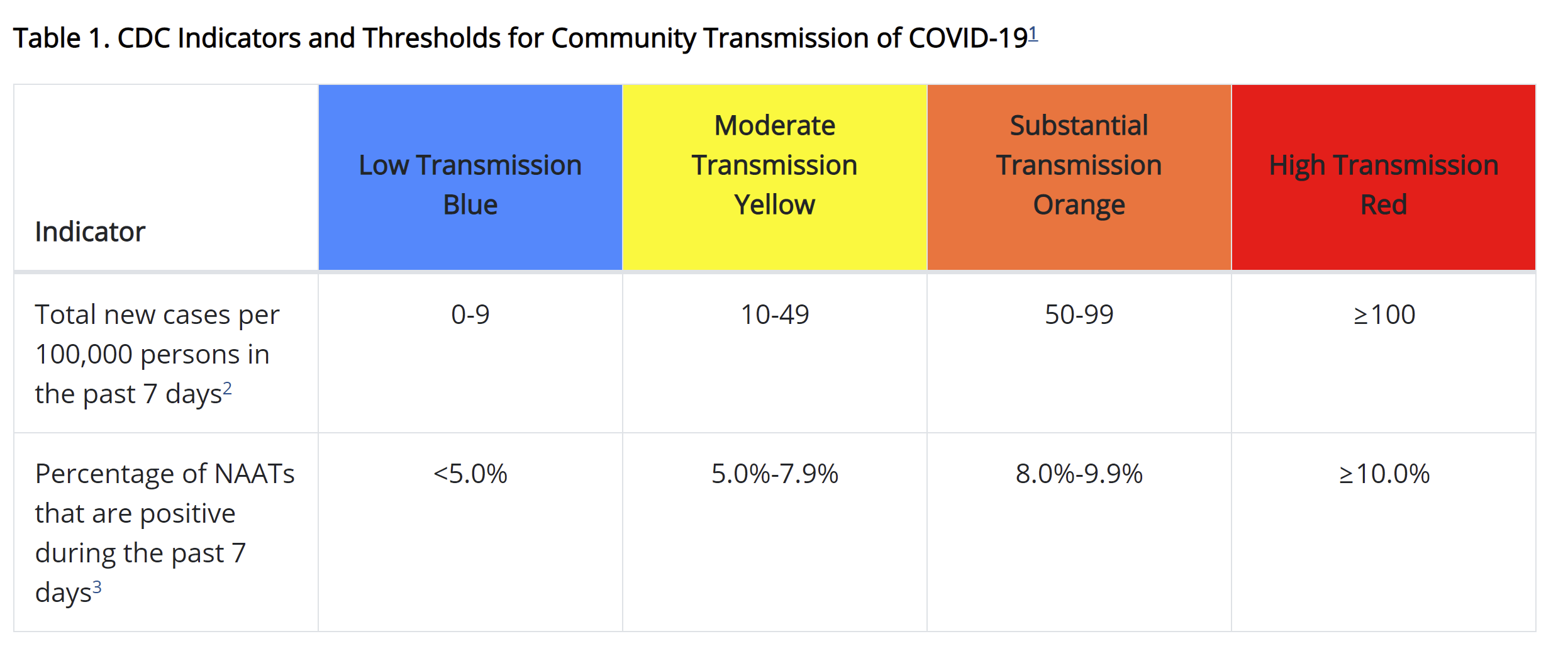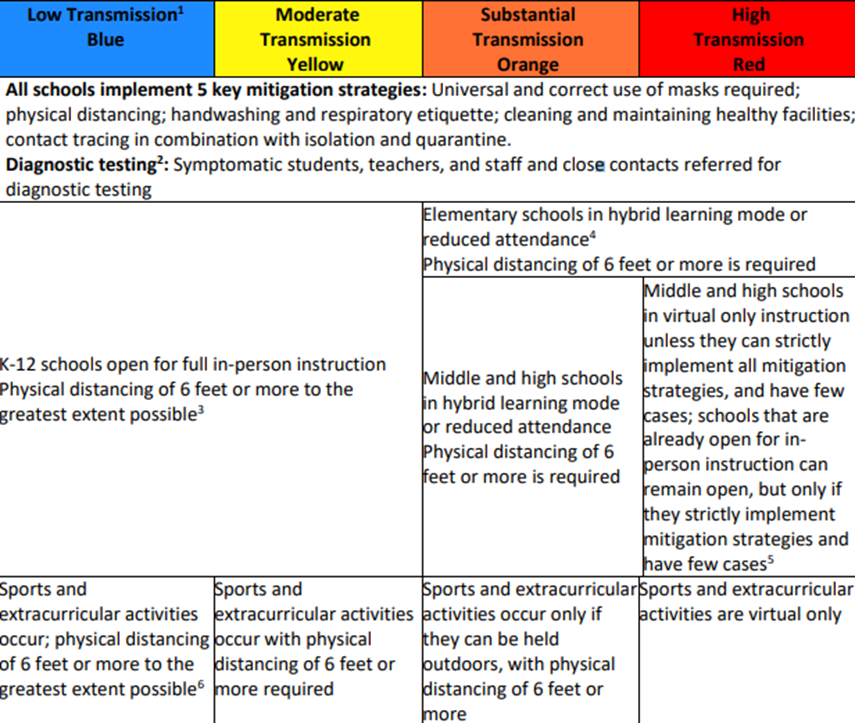Making Sense and Moving Forward: CDC and ED Department Guidance for In-Person Instruction
President Joe Biden has made returning kids to in-person learning a priority in his first 100 days, promising that guidance from the Centers for Disease Control (CDC) would help schools safely meet that goal. The long-awaited guidance from the CDC, issued last Friday, focuses on essential and supplemental mitigation strategies for the safe return to in-person learning. The guidance also provides recommendations for phasing in in-person instruction and activities based on the level of community transmission in an area.
The CDC guidance and guidance from the U.S. Department of Education issued the same day continue to recognize how critical it is for schools to open safely and as soon as possible. However, critics of the new guidelines worry that the recommendations for areas with high levels of transmission, especially physical distancing recommendations, could make it more difficult for schools to reopen than is already the case. For example, the CDC guidance puts Cook County, DuPage County, Lake County, and most of the rest of the country in the “red zone” for which it recommends strict 6-foot distancing, remote-only instruction for middle and high schools not screening or strictly implementing mitigation measures, and no indoor athletics, among other things.
The guidance and recent statements from the CDC addressing it, however, indicate much more flexibility than may be initially apparent. Specifically, the guidance includes recommendations—not requirements—and recognizes that school leaders can and should make decisions about mitigation measures and the appropriate level of reopening through discussions with local health departments and community stakeholders and based on the unique needs of a school and community. This alert explains what the CDC and ED guidance say, whether districts are required to comply with the guidance, and what schools and districts should do next in light of these new guidelines.
What Does the Guidance Say?
The CDC provides the following priority mitigation strategies in the guidance:
- Universal and correct use of masks
- Physical distancing
- Handwashing and respiratory etiquette
- Cleaning and maintaining healthy facilities (including ventilation), and
- Contact tracing in combination with isolation and quarantine.
The Department of Education guidance provides detailed implementation suggestions for each of these strategies, many of which will sound familiar as Illinois school districts are already taking many of these steps. The CDC also explains that the first two strategies are the most critical, and that additional strategies that can provide increased protection, but are not prerequisites for reopening, include screening testing and vaccination of teachers and staff.
The CDC guidance then categorizes communities into levels of transmission risk. The following chart, from the CDC guidance, provides the relevant metrics. Note that if a county is in two different levels, the higher level should be used.

For each level, the CDC recommends use of all mitigation strategies. However, the guidance sets forth different expectations for how strictly to observe physical distancing and the extent of in-person learning and activities based on a community’s transmission level. The following chart from the guidance summarizes the general recommendations:

In schools that conduct routine screening testing for staff and students, the chart is revised so that, for communities in the red transmission zone, hybrid or reduced attendance is recommended. Without routine screening, middle and high schools are recommended to be fully remote unless they can strictly implement all mitigation strategies and have few cases.
Note that, in line with the priority to get students back in classrooms, the CDC guidance recommends no indoor sports be offered for schools in communities in the orange or red zones of community spread. However, with all Illinois regions now in Illinois’ Phase 4, IDPH and ISBE currently permit all Illinois school districts to offer indoor sports with appropriate mitigation measures.
Are Districts Required to Conform with the Guidance?
In the days since the release of the guidance, CDC officials have made numerous public statements to address questions and concerns from education leaders and other stakeholders. Notably, AASA, the School Superintendents Association, conducted a webinar on February 17, 2021 with Dr. Greta Massetti of the CDC and Donna Aiken-Harris of the Department of Education. In the webinar, Dr. Massetti and Ms. Aiken-Harris emphasized that the guidelines are guidance—not binding or mandatory.
The CDC recommends that school leaders collaborate with the local health department and guide their decisions by information on school-specific factors such as the implementation of mitigation strategies, local needs, stakeholder input, school experience, and the number of cases among students, teachers, and staff. One helpful clarification was that where the guidance states that “physical distancing of 6 feet or more is required” when transmission levels are in the orange or red zones, that means the CDC recommends that schools require 6 feet of distancing—not that the CDC requires 6 feet of distancing.
Further, distance between pods and robust implementation of other mitigation strategies can be balanced with less than 6 feet of distancing if the approach proves safe in a given school. Additionally, Dr. Massetti explained that the majority of transmission in schools is between adults, and steps should be taken focused on blunting that spread, such as closing staff gathering areas.
The CDC also recently issued guidance indicating that people who are fully vaccinated (at least 2 weeks following the second dose) within the last three months and who are asymptomatic are not required to quarantine if exposed to someone with suspected or confirmed COVID-19. IDPH has not yet updated its quarantine guidance. The CDC is also reviewing data to determine if the definition of “close contact” should be revised to reflect the reduced likelihood of transmission if both individuals are properly wearing masks. We will continue to monitor the guidance on these evolving issues.
More guidance specific to the educational impacts of the pandemic will be forthcoming: the ED guidance issued on February 12 is “Volume 1,” with additional volumes to follow. Future volumes are expected to provide specific recommendations on various topics like meeting the social, emotional, mental health, and academic needs of students; supporting educator and school staff well-being; addressing lost instructional time; equitable access to broadband and devices; effective use of technology for in-person learning and periodic shifts to remote learning; school nutrition regardless of setting; and others.
Where Do Districts Go From Here?
So, what should Illinois schools do to keep moving forward on the path to in-person reopening? Exactly what you already are doing. Continue collaborating with your local health departments, staff, parents, legal counsel, and communities to develop reopening plans that incorporate the mitigation strategies and meet the unique needs of your communities. For more information on the new Federal guidance or your reopening plan, contact an author of this alert or any other Franczek attorney.